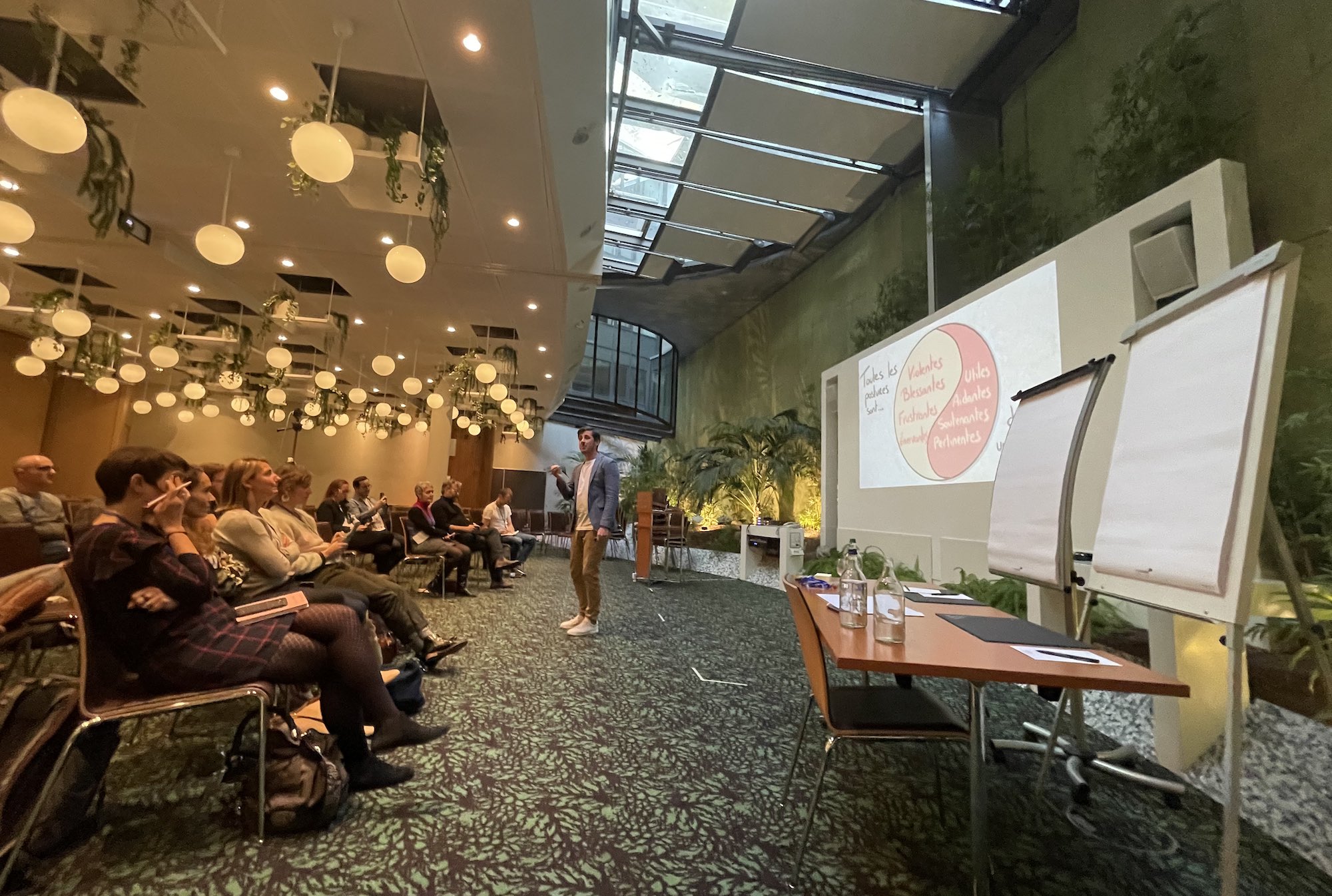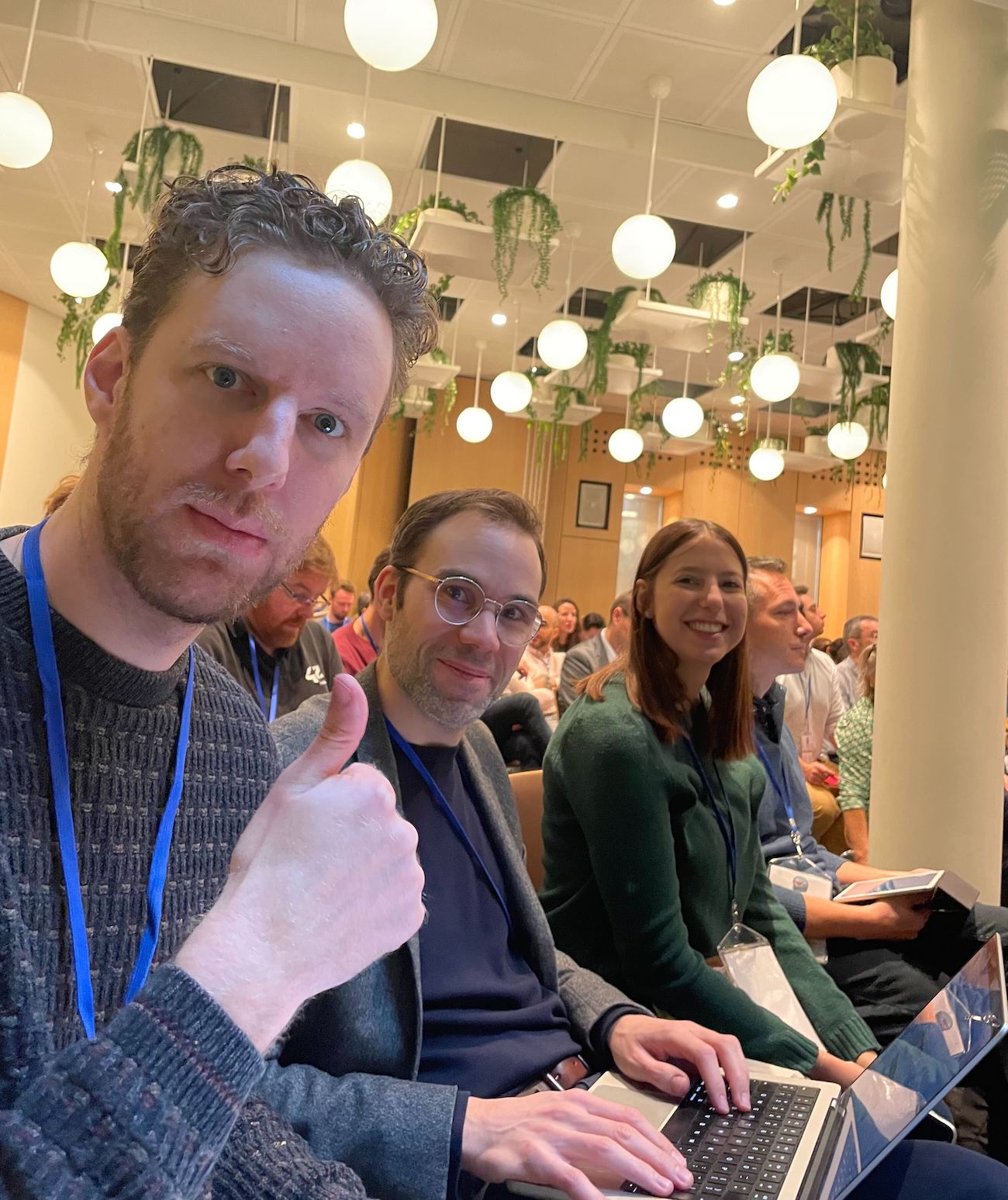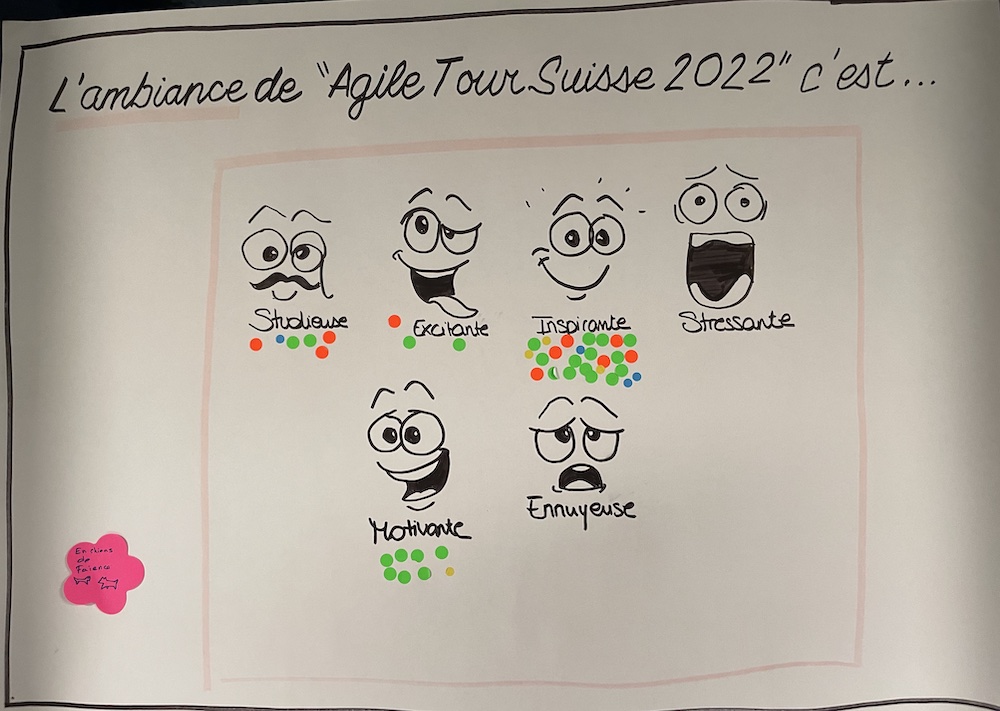AgileTour 2022 – Lausanne
The AgileTour 2022 conference in Lausanne once again brought together a large number of professionals with a passion for agility.
We were lucky enough to attend and took the opportunity to learn new techniques and exchange ideas with the other participants. We're looking forward to putting what we learnt at the conference into practice at our agency.

Among the many talks on the programme, we particularly enjoyed the following:
Marc - Becoming aware of your choice of posture by Thomas Gibot
Thomas Gibot's talk on becoming aware of your choice of posture was particularly instructive and thought-provoking.
Having attended many conferences, I tend to choose the presentations that speak least to me in order to get out of my comfort zone and discover new perspectives. So it was with some trepidation that I attended Thomas' talk, thinking that it would probably be a presentation on communication and how to improve one's 'manipulative paraphernalia'.
I have to admit that I was pleasantly surprised right from the introduction, when Thomas proposed three different versions of the introduction to prove his point about the importance of choosing the right posture.
He explained that our range of postures is very limited and that this range is constructed by our experiences, our traumas and our victories.
He emphasised that all the postures we adopt inevitably have an impact on our message and on the way it is perceived and received. All postures are either Violating, Hurtful, Frustrating, Enervating, Helpful, Supportive or Relevant.

Thomas proposed a method for becoming aware of and containing your message through the way you express yourself. He stressed the importance of being honest and transparent about our conscious choice of posture, by making it clear to the other person that we have chosen this posture and why from the outset. He also stressed the importance of being aware of the posture you have adopted after an interaction, asking yourself whether it worked, how you could have done better and what posture you will adopt for your next meeting.
To sum up, Thomas Gibot's talk on becoming aware of your choice of posture was very interesting and gave me a lot to think about. I highly recommend this presentation to anyone interested in the impact of their posture on their communication and on the way their messages are perceived by others.
Susana - My team does not see the problem in Grégory Alexandre
As a project manager, we often find ourselves faced with a problem that seems important to us, but which is not perceived in the same way by our colleagues. This can create dysfunction within the team and make it difficult to resolve the problem.
Fortunately, at this conference, we learned how to solve this kind of communication problem thanks to three keys.
The first key is to dissect the problem by putting the problem situation into factual terms.
To do this, it's important to ask yourself the following questions: What is the flaw? What is the level of risk? How common is the problem? Who is affected by the problem? If the person affected by the problem can testify to it, this can help to give a concrete example to others.
The second key is to work with the team to find a solution by listening to the opinions and feelings of others. As a project manager, it's important not to try to convince the team of our point of view, but rather to state the problem factually and sincerely question the team about their opinion on the subject. This changes the dynamic of the discussion within the team and provides an opportunity to better understand the opinion of each of the people involved.
If the first two keys are not enough to solve the problem of understanding, there is a third key: working on the problem with yourself. It can be useful to take a step back from the situation and ask yourself what the real impact of this problem is on your working environment and your mental workload.
It's important not to be more of a client than a customer and to ask yourself how you felt before this problem arose. It's also important to ask yourself what would happen if you didn't deal with the problem. Would disaster strike or would nothing happen at all?
To conclude, this conference has given us some tips on how to better manage communication problems within the team. By taking a factual look at the problem, working with all the people involved to find a solution by listening to everyone's feelings, and, if necessary, working on ourselves by taking a step back from the situation, it is possible to better understand the opinion of each person in the project, avoid unnecessary conflicts and gain serenity.

Sasha - Feedback, a double-edged sword by Jérémie Roudaut
At this conference, Jérémie Roudaut focused on the importance of learning to receive and give feedback. We're talking about 'learning' here, because this exercise is not so simple and often hides a great deal of emotion behind it.
Too often reduced to pointing out the mistakes of others, feedback should not be limited to annual appraisal interviews, but should be part of the corporate culture to help each member of the team evolve and develop!
At Antistatique we're already convinced of the benefits of feedback, but thanks to this conference we're going to be able to go one step further and innovate!
But let's start by laying the foundations for this talk…
Most of the time, we tend to be resistant to this feedback culture. Not least because we don't always see the point of it, or we lack knowledge on the subject or even practice.
So it begs the question: what does the feedback culture bring?
- Gives full awareness of each person's strengths
- Gives you a better understanding of yourself
- Enables you to learn from your weaknesses so that you can improve them
The 4 key ingredients for good feedback
- Caring - Always with the intention of helping the other person (constructive)
- Skill-based (communication)
- A gift! Must be offered and proposed to give the person opportunities to improve. The person is then free to act or not!
- Healthy environment. Must be given in a healthy environment, with a certain degree of psychological safety.
“ "Psychological safety is the belief that one will not be punished or humiliated for expressing ideas, questions, concerns or mistakes." ”Amy C. Edmondson
Leadership expert
What do we give feedback on?
- Knowledge - Knowledge & Experience
- Know-how - Putting theory into practice on a day-to-day basis
- Personal skills - A person's attitude and values
⚠️ The feedback trap - If given incorrectly, feedback is in fact judgmental, which prevents it from being constructive and adds a great deal of emotion.
A few tips on how to give good feedback?
- Offer feedback by clarifying your intention (benevolence)
- Ask if the person agrees to receive feedback (do not impose)
There are 2 methods to help you
- OSCAR Model
- Non-violent communication (Marshall Bertram Rosenberg)
“ "Giving feedback isn't innate; it has to be learnt and practised. Be indulgent!" ”Jérémie Roudaut
Agile Coach / Scrum Master & Speaker
Here are some examples of how feedback can be received
Thanks to this talk, we'll even be leaving with some practical exercises to put into practice, which we're looking forward to trying out at Antistatique!
- Positive ball >> Everyone throws a ball at each other. The aim is to keep the ball for as short a time as possible while giving positive feedback to the person of your choice, then throw the ball to them.
- Kudo cards >> Materialise positive feedback on a card (it can be a drawing).
- Retrospectives >> Create opportunities in your retrospectives to give each other feedback.
- Feedback angel or Secret Feedback >> Each person will have another person designated as their unknown guardian angel who can observe them and give them feedback.
- Speed feedback >> Form peers. They have 5 minutes to give each other positive feedback and a suggestion for improvement.
- Feedback tour >> Show the team members on the walls. Give the team 15 minutes to stick feedbacks where people want them. Then go through the feedbacks for each person together.
- Perfection game >> Someone nominates themselves to present a topic. The rest of the team evaluates the presentation and gives feedback with concrete suggestions for improvement.
- Feedback box >> One person volunteers to receive feedback. A number of questions will be put in a box, such as: what do you appreciate most about this person? what are their strengths? etc.

Looking forward to next year
In conclusion, we'd like to thank all the organisers of this conference for their hard work and commitment.
This conference was a very rewarding opportunity to discover new techniques and discuss with professionals who are passionate about agility. It also allowed us to meet up with some familiar faces and to get together with other enthusiasts.
We're already looking forward to the 2024 edition of the conference and hope to attend again.